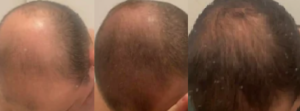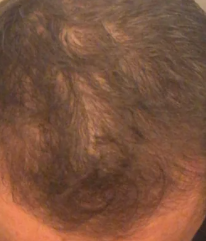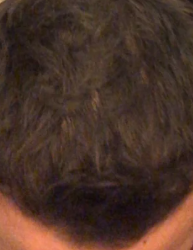I started noticing diffuse thinning when I was around 14 and four years later it has gotten more noticeable. I have been taking finasteride and minoxidil for 3 months and still waiting for progress. As I started thinning very early on, I’m curious to know if that affects my potential to see growth or my chances of responding. Anyone else have a similar case?
It is rare for significant balding in the form of recession and the development of a Norwood Class 3 pattern of balding or greater to be seen in a man under 18. Then, if you are on-top of it, you have a good chance at stopping the balding in its tracks.
No. Minoxidil is not a DHT blocker so I wouldn’t expect the type of side effects seen with finasteride.
I recently discovered that Dutasteride has a half life of 4-5 weeks. I am considering getting off of Dutasteride (daily usage for about 3 years) completely because I feel like it is heavily contributing to my anxiety (timing is very similar). I am on no other hair loss remedies currently but have had one temporal area hair transplant. If I discontinue Dutasteride or take it less frequently, what therapies seem to be working for people nowadays? With such a long half-life, couldn’t Dutasteride hypothetically be taken once a week or potentially less and maybe still have similar results?
In theory, you are correct; with a long half-life, one would expect that a once-a-week dosing might be enough, but for reasons I personally don’t understand, dosage recommendations have been more frequent. As the FDA has not cleared dutasteride for hair loss use, this is a real problem for doctors, i.e. to find the correct approved dose. The blood levels may have a half-life of 4-5 weeks, but the tissues in which the dutasteride is embedded have a much longer presence in your body that could go up to a 1/2 year or more. That means if you get side effects, it may be a long time to get rid of them because dutasteride is in your tissues 6 or more months.
I take finasteride 1mg every other day for a year and just recently noticed that the hairline is thining. What you would think it the best thing I can do now?
I would increase your dose to daily rather than every other day. See if that makes a difference with the finasteride. You could add microneedling weekly.
Dr. Rassman in your practice have you ever had a patient with an adverse reaction to oral min? Thanks so much!
Yes, some people can’t tolerate this medication for one of many reasons, and the blood pressure effects can be disabling for a few people, with lightheaded and rapid heart beat. Here is a list of some of the side effects of minoxidil. Some of these side effects only relate to the topical application of minoxidil.
- Fluid retention
- Facial hair growth
- Fast heartbeat
- Hair shedding
- Irritation
- Nausea
- Acne
- Burning of scalp
- Chest pain
- Fainting
- Headaches
- Application site redness
- Difficulty breathing
- Hypertrichosis
- Redness
- Swelling of face
- Breast tenderness
- Burning
- Low blood pressureReddened skin
- Weight gain
- Hair texture changes
- Heart palpitations
- Cardiac Tamponade (very rare with a lot of early signs of it but potentially deadly)
So if tissue levels remain for 6 days, would topical application every 4/5 days be theoretically still somewhat effective?
Some amount of finasteride stays in the tissues for more than two weeks after stopping the pill. Daily dosing is the ideal way to build appropriate tissue levels.
My hair is medium-coarse. I had two sessions totaling 5500 grafts. Do you think that it too many grafts from my donor area?
The men who most tolerate 5500 grafts excised from the back of the head are men with a coarser hair. That puts you in this category, so I would worry less, assuming that the FUE was done correctly with good spacing and no donor area shock loss.
I’ve been on fin for 5 years and had great results. Whatever reason my crown is really thinning again, fast. Should I just up and take oral min too
Adding oral minoxidil might help as it has a different mechanism of action.
Reducing the dose to 0.5% of finasteride may help some men with symptoms. The half dose is 82% as effective as the full dose.
21 y/o M Currently been on fin 1mg ED for over a year and a half. Closing in on one year oral min 2.5 mg ED. Got some great results from the combination until about February time I’ve slowly started to get worse and worse. Im still above baseline but I’m starting to consider other options. What do y’all think. Not just my case in specific but in general would it be bad to get a transplant because of shock loss etc?
Male Patterned Balding is not a problem that stays fixed after you treat it with finasteride. It is a progressive problem and continues with age until you reach your final inherited balding pattern. Generally, that pattern can be estimated best when a man is over 26; however, in some cases, the final pattern can be determined with 80% accuracy) with an experienced hair surgeon. Circumstances do occur when I transplant someone of your age. Still, I require a relationship between the patient and me so I can determine factors like (1) examination elements to determine donor density and donor hair mass), (2) maturity, (3) stable mental state, (4) the finances to finish a worst case scenario if you start going that route and (5) worst case patterned balding that you might develop over the next 5 years. By worst case, I mean hair loss acceleration after a hair transplant (something I usually can predict before the transplant) and the use of medications like finasteride, or oral minoxidil, or topical liposomal finasteride (which mostly stays in the scalp.
I have been on finasteride for more than 10 years, then I decided just recently to stop it. I lost basically everything in 3 months when I stopped min/fin. I started back 30 days ago is it possible to regain everything?
It is possible that some or all of the hair is still there. Good luck with a potential reversal. Let me know in 3 months so I know. I always want to be educated by the men who are balding and dealing with such problems.
For someone paranoid about balding, but currently too poor to do anything about it aside from fin/min (oral+top) and derma-stamping, is there any way to somehow save donor area hair for the future? I worry that if financial security ever comes, it’ll be too late as far as my donor area is concerned. Any cheap solution to this? Do I just scalp myself and toss it in the freezer? (Kidding).
The donor area remains intact in most men throughout their early years until 60. After 60, some men start losing their donor area hair. This is a normal process and nothing to worry about. Freezing hair for future use sounds extreme to me and not practical today.
Page 46 of 1247




